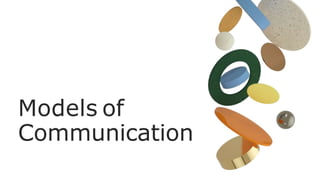
Models of Communication.pptx
- 2. How does the communication process work?
- 3. Differentiates the various models of communication 01 Describe the linear, interactive, and transactional models of communication 02 Explain the models of communication 03 Lesson Objectives
- 4. Linear Model of Communication 01 Aristotelian Model 02 Laswell Model 03 Shannon & Weaver Model 04 Berlo's Model
- 5. Aristotelian Model A linear model that has 3 elements: (1) speaker, (2) the message, (3) the audience. The 3 modes of persuasion are: (1) ethos, (2) pathos, (3) logos.
- 7. Harold Laswell (1948) named 5 components in communication: (1) Communicator, (2) Message, (3) Channel, (4) Receiver, and (5) Effect. A channel is a medium of communication through which the information is conveyed.
- 10. Shannon & Weaver Model (1949) Noise is any form of interference which affects the meaning, or disrupts the flow, of communication. Noise may be external, physiological, psychological, or semantic. Communication is one-way, and the speaker transmits the message to a passive listener.
- 11. Berlo's Model David Berlo (1960) developed the SMCR model of communication. Comprised of 4 basic elements: source, message, channel, receiver.
- 13. Interactive Models of Communication Schramm's Models 01 02 White's Model
- 15. Schramm's Model Each of the communicators take on the roles of an encoder, interpreter, and decoder in the communication process. The communication process is cyclical instead of sequential.
- 16. Schramm's Model Schramm emphasized the importance of people's fields of experience in the interpretation of meaning. Both the communicators must share similar experiences or common schematic background about the topic of conversation in order to connect with, and understand each other.
- 17. White's Model Eugene White's model recognizes feedback as part of the communication process. Described the process as cyclical and sequential, following 8 stages of oral communication.
- 18. White's Model These stages are: Thinking Symbolizing Expressing Transmitting Receiving Decoding Feedbacking Monitoring
- 19. Transactional Model of Communication 01 Wood's Transactional Model of Communication 02 Speech Communication Transaction Model
- 20. Wood's Transactional Model of Communication Julia Wood's model portrayed communication as a dynamic process, which continually changes over time depending on previous interactions. How you communicate to your parents, teachers, and peers is influenced by the history of your relationships and the way you communicated with them in the past.
- 21. Wood's Transactional Model of Communication The communicators have an active role in constructing the meaning of the message. Feedback may be verbal or nonverbal. A communicator simultaneously receives information by interpreting nonverbal gestures.
- 22. Speech Communication Transaction Model Feedback may be intentional or unintentional, verbal or non-verbal. Feedback moves in both directions and may simultaneously come from both the speaker and listener. Represent public communication Composed of the following elements: speaker, listeners, feedback, message, channel, situation, and cultural context.
- 23. Speech Communication Transaction Model Listeners are characterized by: their purpose of listening knowledge and interest about the topic listening skills attitude towards self and the speaker ideas or information presented Credibility Self-concept Attitude toward self and others Knowledge of the subject Intention Purpose of communication Speakers may be evaluated according to:
- 24. Speech Communication Transaction Model Types of Channels Verbal Visual Aural or paralinguistic Pictorial Content Structure Style 3 Aspects of a Message
